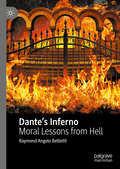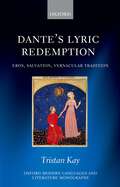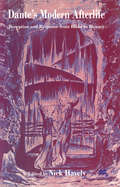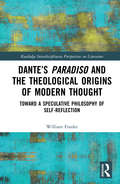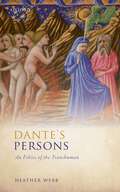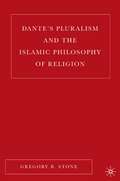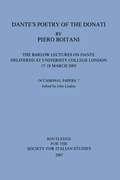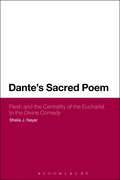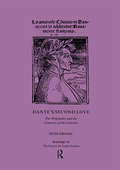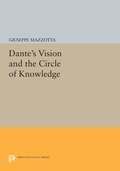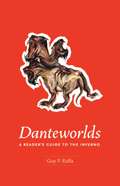- Table View
- List View
Dante's Education: Latin Schoolbooks and Vernacular Poetics (Oxford Studies in Medieval Literature and Culture)
by Filippo GianferrariIn fourteenth-century Italy, literacy became accessible to a significantly larger portion of the lay population (allegedly between 60 and 80 percent in Florence) and provided a crucial means for the vernacularization and secularization of learning, and for the democratization of citizenship. Dante Alighieri's education and oeuvre sit squarely at the heart of this historical and cultural transition and provide an ideal case study for investigating the impact of Latin education on the consolidation of autonomous vernacular literature in the Middle Ages, a fascinating and still largely unexamined phenomenon. On the basis of manuscript and archival evidence, Gianferrari reconstructs the contents, practice, and readings of Latin instruction in the urban schools of fourteenth-century Florence. It also shows Dante's continuous engagement with this culture of teaching in his poetics, thus revealing his contribution to the expansion of vernacular literacy and education. The book argues that to achieve his unprecedented position of authority as a vernacular intellectual, Dante conceived his poetic works as an alternative educational program for laypeople, who could read and write in the vernacular but had little or no proficiency in Latin. By reconstructing the culture of literacy shared by Dante and his lay readers, Dante's Education shifts critical attention from his legacy as Italy's national poet, and a "great books" author in the Western canon, to his experience as a marginal intellectual engaged in advancing a marginal culture.
Dante's Education: Latin Schoolbooks and Vernacular Poetics (Oxford Studies in Medieval Literature and Culture)
by Filippo GianferrariIn fourteenth-century Italy, literacy became accessible to a significantly larger portion of the lay population (allegedly between 60 and 80 percent in Florence) and provided a crucial means for the vernacularization and secularization of learning, and for the democratization of citizenship. Dante Alighieri's education and oeuvre sit squarely at the heart of this historical and cultural transition and provide an ideal case study for investigating the impact of Latin education on the consolidation of autonomous vernacular literature in the Middle Ages, a fascinating and still largely unexamined phenomenon. On the basis of manuscript and archival evidence, Gianferrari reconstructs the contents, practice, and readings of Latin instruction in the urban schools of fourteenth-century Florence. It also shows Dante's continuous engagement with this culture of teaching in his poetics, thus revealing his contribution to the expansion of vernacular literacy and education. The book argues that to achieve his unprecedented position of authority as a vernacular intellectual, Dante conceived his poetic works as an alternative educational program for laypeople, who could read and write in the vernacular but had little or no proficiency in Latin. By reconstructing the culture of literacy shared by Dante and his lay readers, Dante's Education shifts critical attention from his legacy as Italy's national poet, and a "great books" author in the Western canon, to his experience as a marginal intellectual engaged in advancing a marginal culture.
Dante's Epic Journeys
by David ThompsonThis essay in comparative literature represents the first extended attempt to relate Dante's major allegorical mode to classical and medieval interpretations of epic poetry rather than to patristic biblical exegesis. It also is the first comprehensive explanation of Dante's enigmatic Ulysses. Thompson strives to shed new light not only on Dante's allegory—and thus upon the whole troubled question of exactly what an allegory was thought to be—but also on the intricate relationship between poet and poem and between Dante's spiritual journeys and his written representation of those itineraries.
Dante's Epic Journeys
by David ThompsonThis essay in comparative literature represents the first extended attempt to relate Dante's major allegorical mode to classical and medieval interpretations of epic poetry rather than to patristic biblical exegesis. It also is the first comprehensive explanation of Dante's enigmatic Ulysses. Thompson strives to shed new light not only on Dante's allegory—and thus upon the whole troubled question of exactly what an allegory was thought to be—but also on the intricate relationship between poet and poem and between Dante's spiritual journeys and his written representation of those itineraries.
Dante's Epic Journeys
by David ThompsonThis essay in comparative literature represents the first extended attempt to relate Dante's major allegorical mode to classical and medieval interpretations of epic poetry rather than to patristic biblical exegesis. It also is the first comprehensive explanation of Dante's enigmatic Ulysses. Thompson strives to shed new light not only on Dante's allegory—and thus upon the whole troubled question of exactly what an allegory was thought to be—but also on the intricate relationship between poet and poem and between Dante's spiritual journeys and his written representation of those itineraries.
Dante’s Inferno: Moral Lessons from Hell
by Raymond Angelo BelliottiThis book provides a recipe for healthy moral and personal transformation. Belliotti takes seriously Dante’s deepest yearnings: to guide human well-being; to elevate social and political communities; to remedy the poisons spewed by the seven capital vices; and to celebrate the connections between human self-interest, virtuous living, and spiritual salvation. By closely examining and analyzing five of Dante’s more vivid characters in hell—Piero della Vigna, Brunetto Latini, Farinata degli Uberti, Cavalcante de’ Cavalcanti, and Guido da Montefeltro—and extracting the moral lessons Dante intends them to convey, and by conceptually analyzing envy, arrogance, pride, and human flourishing, the author challenges readers to interrogate and refine their modes of living.
Dante's Lyric Redemption: Eros, Salvation, Vernacular Tradition (Oxford Modern Languages and Literature Monographs)
by Tristan KayDante's Lyric Redemption offers a re-examination of two strongly interrelated aspects of the poet's work: the role and value he ascribes to earthly love and his relationship to the Romance lyric tradition of his time. It argues that an account of Dante's poetic journey that posits a stark division between earthly and divine love, and between the secular lyric poet and the Christian auctor, does little justice to his highly distinctive and often polemical handling of these categories. The book firstly contextualizes, traces, and accounts for Dante's intriguing commitment to love poetry, from the 'minor works' to the Commedia. It highlights his attempts, especially in his masterpiece, to overcome normative oppositions in formulating a uniquely redemptive vernacular poetics, one oriented towards the eternal while rooted in his affective, and indeed erotic, past. It then examines how this matter is at stake in Dante's treatment of three important lyric predecessors: Guittone d'Arezzo, Arnaut Daniel, and Folco of Marseilles. Through a detailed reading of Dante's engagement with these poets, the book illuminates his careful departure from a dualistic model of love and conversion and shows his erotic commitment to be at the heart of his claims to pre-eminence as a vernacular author.
Dante's Masterplot and Alternative Narratives in the Commedia (Oxford Modern Languages and Literature Monographs)
by Nicolò CrisafiDante's Masterplot and Alternative Narratives in the 'Commedia' questions the familiar narrative arc at play in the writings of Dante Alighieri and opens his masterpiece to three alternative models that resist it. Dante's masterplot is the teleological trajectory by which the poet subordinates the past to the authority of a new experience. The book analyses the masterplot's workings in Dante's text and its role in the interpretation of the poem, and it documents its overwhelming success in influencing readings of the Commedia over the centuries. The volume then explores three competing narrative models that resist and counter its monopoly which are enacted by paradoxes, alternative endings and parallel lives, and the future. By focusing on these non-linear modes of storytelling and testing the limits of linear narration, the book questions critical paradigms in the scholarship of the Commedia that favour a single normative master truth, exposes their problematic authoritarian implications, and highlights the manifold poetic, theological, and ethical tensions that are often neglected due to the masterplot's influence. The new picture of a vulnerable author and open-ended text that emerges from this study thus doubles as a metacritical reflection on the state of the field. The book's impassioned argument is that, alongside established notions of his trademark plurality of linguistic registers and styles, Dante's narrative pluralism can, and should, come to play a key role in contemporary and future readings of the Commedia.
Dante's Masterplot and Alternative Narratives in the Commedia (Oxford Modern Languages and Literature Monographs)
by Nicolò CrisafiDante's Masterplot and Alternative Narratives in the 'Commedia' questions the familiar narrative arc at play in the writings of Dante Alighieri and opens his masterpiece to three alternative models that resist it. Dante's masterplot is the teleological trajectory by which the poet subordinates the past to the authority of a new experience. The book analyses the masterplot's workings in Dante's text and its role in the interpretation of the poem, and it documents its overwhelming success in influencing readings of the Commedia over the centuries. The volume then explores three competing narrative models that resist and counter its monopoly which are enacted by paradoxes, alternative endings and parallel lives, and the future. By focusing on these non-linear modes of storytelling and testing the limits of linear narration, the book questions critical paradigms in the scholarship of the Commedia that favour a single normative master truth, exposes their problematic authoritarian implications, and highlights the manifold poetic, theological, and ethical tensions that are often neglected due to the masterplot's influence. The new picture of a vulnerable author and open-ended text that emerges from this study thus doubles as a metacritical reflection on the state of the field. The book's impassioned argument is that, alongside established notions of his trademark plurality of linguistic registers and styles, Dante's narrative pluralism can, and should, come to play a key role in contemporary and future readings of the Commedia.
Dante's Modern Afterlife: Reception and Response from Blake to Heaney
by Nick HavelyDante's persistent and pervasive presence has been a remarkable feature of modern writing since the late eighteenth century. This collection of essays by an international group of scholars emphasizes that presence in the work of major British and Irish writers (such as Blake, Shelley, Joyce and Heaney). It also focuses on responses in America, the Caribbean and Italy and deals with appropriations of Dante's work by poets (from Gray to Walcott) and novelists (such as Mary Shelley and Giorgio Bassani, and Gloria Naylor).
Dante's New Life of the Book: A Philology of World Literature (Oxford Textual Perspectives)
by Martin EisnerDante's Vita nuova has taken on a wide variety of different forms since its first publication in 1294. How could one work have generated such different physical forms? Through examining the work's transformations in manuscripts, printed books, translations, and adaptations, Eisner reconceives of the relationship between the work and its reception. Dante's New Life of the Book investigates how these different material manifestations participate in the work, drawing attention to its distinctive elements. Dante framed his book as an attempt to understand his own experiences through the experimental form of the book, and later scribes, editors, and translators use different material forms to embody their interpretations of Dante's collection of thirty-one poems surrounded by prose narrative and commentary. Traveling from Boccaccio's Florence to contemporary Hollywood with stops in Emerson's Cambridge, Rossetti's London, Nerval's Paris, Mandelstam's Russia, De Campos's Brazil, and Pamuk's Istanbul, this study builds on extensive archival research to show how Dante's strange poetic forms, including incomplete canzoni and sonnets with two beginnings, continue to challenge readers. Each chapter focuses on how one of these distinctive features has been treated over time, offering new perspectives on topics such as Dante's love of Beatrice, his relationship with Guido Cavalcanti, and his attraction to another woman. Numerous illustrations show the entanglement of the work's poetic form and its material survival. Eisner provides a fresh reading of Dante's innovations, demonstrating the value of this philological analysis of the work's survival in the world.
Dante’s Paradiso and the Theological Origins of Modern Thought: Toward a Speculative Philosophy of Self-Reflection (Routledge Interdisciplinary Perspectives on Literature)
by William FrankeSelf-reflection, as the hallmark of the modern age, originates more profoundly with Dante than with Descartes. This book rewrites modern intellectual history, taking Dante’s lyrical language in Paradiso as enacting a Trinitarian self-reflexivity that gives a theological spin to the birth of the modern subject already with the Troubadours. The ever more intense self-reflexivity that has led to our contemporary secular world and its technological apocalypse can lead also to the poetic vision of other worlds such as those experienced by Dante. Facing the same nominalist crisis as Duns Scotus, his exact contemporary and the precursor of scientific method, Dante’s thought and work indicate an alternative modernity along the path not taken. This other way shows up in Nicholas of Cusa’s conjectural science and in Giambattista Vico’s new science of imagination as alternatives to the exclusive reign of positive empirical science. In continuity with Dante’s vision, they contribute to a reappropriation of self-reflection for the humanities.
Dante’s Paradiso and the Theological Origins of Modern Thought: Toward a Speculative Philosophy of Self-Reflection (Routledge Interdisciplinary Perspectives on Literature)
by William FrankeSelf-reflection, as the hallmark of the modern age, originates more profoundly with Dante than with Descartes. This book rewrites modern intellectual history, taking Dante’s lyrical language in Paradiso as enacting a Trinitarian self-reflexivity that gives a theological spin to the birth of the modern subject already with the Troubadours. The ever more intense self-reflexivity that has led to our contemporary secular world and its technological apocalypse can lead also to the poetic vision of other worlds such as those experienced by Dante. Facing the same nominalist crisis as Duns Scotus, his exact contemporary and the precursor of scientific method, Dante’s thought and work indicate an alternative modernity along the path not taken. This other way shows up in Nicholas of Cusa’s conjectural science and in Giambattista Vico’s new science of imagination as alternatives to the exclusive reign of positive empirical science. In continuity with Dante’s vision, they contribute to a reappropriation of self-reflection for the humanities.
Dante's Persons: An Ethics of the Transhuman
by Heather WebbDante's Persons explores the concept of personhood as it appears in Dante's Commedia and seeks out the constituent ethical modes that the poem presents as necessary for attaining a fullness of persona. The study suggests that Dante presents a vision of 'transhuman' potentiality in which the human person is, after death, fully integrated into co-presence with other individuals in a network of relations based on mutual recognition and interpersonal attention. The Commedia, Heather Webb argues, aims to depict and to actively construct a transmortal community in which the plenitude of each individual's person is realized in and through recognition of the personhood of other individuals who constitute that community, whether living or dead. Webb focuses on the strategies the Commedia employs to call us to collaborate in the mutual construction of persons. As we engage with the dead that inhabit its pages, we continue to maintain the personhood of those dead. Webb investigates Dante's implicit and explicit appeals to his readers to act in relation to the characters in his otherworlds as if they were persons. Moving through the various encounters of Purgatorio and Paradiso, this study documents the ways in which characters are presented as persone in development or in a state of plenitude through attention to the 'corporeal' modes of smiles, gazes, gestures, and postures. Dante's journey provides a model for the formation and maintenance of a network of personal attachments, attachments that, as constitutive of persona, are not superseded even in the presence of the direct vision of God.
Dante's Persons: An Ethics of the Transhuman
by Heather WebbDante's Persons explores the concept of personhood as it appears in Dante's Commedia and seeks out the constituent ethical modes that the poem presents as necessary for attaining a fullness of persona. The study suggests that Dante presents a vision of 'transhuman' potentiality in which the human person is, after death, fully integrated into co-presence with other individuals in a network of relations based on mutual recognition and interpersonal attention. The Commedia, Heather Webb argues, aims to depict and to actively construct a transmortal community in which the plenitude of each individual's person is realized in and through recognition of the personhood of other individuals who constitute that community, whether living or dead. Webb focuses on the strategies the Commedia employs to call us to collaborate in the mutual construction of persons. As we engage with the dead that inhabit its pages, we continue to maintain the personhood of those dead. Webb investigates Dante's implicit and explicit appeals to his readers to act in relation to the characters in his otherworlds as if they were persons. Moving through the various encounters of Purgatorio and Paradiso, this study documents the ways in which characters are presented as persone in development or in a state of plenitude through attention to the 'corporeal' modes of smiles, gazes, gestures, and postures. Dante's journey provides a model for the formation and maintenance of a network of personal attachments, attachments that, as constitutive of persona, are not superseded even in the presence of the direct vision of God.
Dante’s Pluralism and the Islamic Philosophy of Religion
by G. StoneThis book explores the Islamic roots of the Western values of tolerance and religious pluralism, and considers Dante from the perspective of the Arab-Islamic philosophical tradition. It examines the relations between Islamic and Western thought, the historical origins of Western values, and the tradition of tolerance in classical Islamic thought.
Dante's Poetry of Donati: The Barlow Lectures on Dante Delivered at University College London, 17-18 March 2005
by Piero Boitani"Members of the Florentine family of the Donati feature prominently in Dante's Divine Comedy . Their presence is explored by Piero Boitani, as a 'comedy' within the Comedy, in close readings of the three major episodes in which they appear, one for each of Inferno , Purgatorio , and Paradiso ."
Dante's Poetry of Donati: The Barlow Lectures on Dante Delivered at University College London, 17-18 March 2005
by Piero Boitani"Members of the Florentine family of the Donati feature prominently in Dante's Divine Comedy . Their presence is explored by Piero Boitani, as a 'comedy' within the Comedy, in close readings of the three major episodes in which they appear, one for each of Inferno , Purgatorio , and Paradiso ."
Dante's Sacred Poem: Flesh and the Centrality of the Eucharist to The Divine Comedy
by Sheila J. NayarArguing that the consecrated body in the Eucharist is one of the central metaphors structuring The Divine Comedy, this book is the first comprehensive exploration of the theme of transubstantiation across Dante's epic poem. Drawing attention first to the historical and theological tensions inherent in ideas of transubstantiation that rippled through Western culture up to the early fourteenth century, Sheila Nayar engages in a Eucharistic reading of both the "flesh" allusions and "metamorphosis" motifs that thread through the entirety of Dante's poem. From the cannibalistic resonances of the Ugolino episode in the Inferno to the Corpus Christi-like procession seminal to Purgatory, Nayar demonstrates how these sacrifice- and Host-related metaphors, allusions, and tropes lead directly and intentionally to the Comedy's final vision, that of the Eucharist itself. Arguing that the final revelation in Paradise is analogically "the Bread of Life," Nayar brings to the fore Christ's centrality (as sacrament) to The Divine Comedy-a reading that is certain to alter current-day thinking about Dante's poem.
Dante's Sacred Poem: Flesh and the Centrality of the Eucharist to The Divine Comedy
by Sheila J. NayarArguing that the consecrated body in the Eucharist is one of the central metaphors structuring The Divine Comedy, this book is the first comprehensive exploration of the theme of transubstantiation across Dante's epic poem. Drawing attention first to the historical and theological tensions inherent in ideas of transubstantiation that rippled through Western culture up to the early fourteenth century, Sheila Nayar engages in a Eucharistic reading of both the "flesh" allusions and "metamorphosis" motifs that thread through the entirety of Dante's poem. From the cannibalistic resonances of the Ugolino episode in the Inferno to the Corpus Christi-like procession seminal to Purgatory, Nayar demonstrates how these sacrifice- and Host-related metaphors, allusions, and tropes lead directly and intentionally to the Comedy's final vision, that of the Eucharist itself. Arguing that the final revelation in Paradise is analogically "the Bread of Life," Nayar brings to the fore Christ's centrality (as sacrament) to The Divine Comedy-a reading that is certain to alter current-day thinking about Dante's poem.
Dante's Second Love: The Originality and the Contexts of the Convivio
by Peter Dronke"Three essays on the nature of the bonds between Vita Nuova and Convivio; the nature and significance of the Donna Gentile, Dante's 'second love'; and the imaginative and intellectual coherence of the third and fourth treatises of the Convivio . An excursus comments on the Donna Gentile's fate at the hands of scholars."
Dante's Second Love: The Originality and the Contexts of the Convivio
by Peter Dronke"Three essays on the nature of the bonds between Vita Nuova and Convivio; the nature and significance of the Donna Gentile, Dante's 'second love'; and the imaginative and intellectual coherence of the third and fourth treatises of the Convivio . An excursus comments on the Donna Gentile's fate at the hands of scholars."
Dante's Vision and the Circle of Knowledge (PDF)
by Giuseppe MazzottaIn a masterly synthesis of historical and literary analysis, Giuseppe Mazzotta shows how medieval knowledge systems--the cycle of the liberal arts, ethics, politics, and theology--interacted with poetry and elevated the Divine Comedy to a central position in shaping all other forms of discursive knowledge. To trace the circle of Dante's intellectual concerns, Mazzotta examines the structure and aims of medieval encyclopedias, especially in the twelfth and thirteenth centuries; the medieval classification of knowledge; the battle of the arts; the role of the imagination; the tension between knowledge and vision; and Dante's theological speculations in his constitution of what Mazzotta calls aesthetic, ludic theology. As a poet, Dante puts himself at the center of intellectual debates of his time and radically redefines their configuration. In this book, Mazzotta offers powerful new readings of a poet who stands amid his culture's crisis and fragmentation, one who responds to and counters them in his work. In a critical gesture that enacts Dante's own insight, Mazzotta's practice is also a fresh contribution to the theoretical literary debates of the present.Originally published in 1992.The Princeton Legacy Library uses the latest print-on-demand technology to again make available previously out-of-print books from the distinguished backlist of Princeton University Press. These editions preserve the original texts of these important books while presenting them in durable paperback and hardcover editions. The goal of the Princeton Legacy Library is to vastly increase access to the rich scholarly heritage found in the thousands of books published by Princeton University Press since its founding in 1905.
Danteworlds: A Reader's Guide to the Inferno
by Guy P. RaffaOne of the greatest works of world literature, Dante Alighieri’s The Divine Comedy has, despite its enormous popularity and importance, often stymied readers with its multitudinous characters, references, and themes. But until now, students of the Inferno have lacked a suitable resource to guide their reading. Welcome to Danteworlds, the first substantial guide to the Inferno in English. Guy P. Raffa takes readers on a geographic journey through Dante’s underworld circle by circle—from the Dark Wood down to the ninth circle of Hell—in much the same way Dante and Virgil proceed in their infernal descent. Each chapter—or “region”—of the book begins with a summary of the action, followed by detailed entries, significant verses, and useful study questions. The entries, based on a close examination of the poet’s biblical, classical, and medieval sources, help locate the characters and creatures Dante encounters and assist in decoding the poem’s vast array of references to religion, philosophy, history, politics, and other works of literature. Written by an established Dante scholar and tested in the fire of extensive classroom experience, Danteworlds will be heralded by readers at all levels of expertise, from students and general readers to teachers and scholars.
Danteworlds: A Reader's Guide to the Inferno
by Guy P. RaffaOne of the greatest works of world literature, Dante Alighieri’s The Divine Comedy has, despite its enormous popularity and importance, often stymied readers with its multitudinous characters, references, and themes. But until now, students of the Inferno have lacked a suitable resource to guide their reading. Welcome to Danteworlds, the first substantial guide to the Inferno in English. Guy P. Raffa takes readers on a geographic journey through Dante’s underworld circle by circle—from the Dark Wood down to the ninth circle of Hell—in much the same way Dante and Virgil proceed in their infernal descent. Each chapter—or “region”—of the book begins with a summary of the action, followed by detailed entries, significant verses, and useful study questions. The entries, based on a close examination of the poet’s biblical, classical, and medieval sources, help locate the characters and creatures Dante encounters and assist in decoding the poem’s vast array of references to religion, philosophy, history, politics, and other works of literature. Written by an established Dante scholar and tested in the fire of extensive classroom experience, Danteworlds will be heralded by readers at all levels of expertise, from students and general readers to teachers and scholars.


